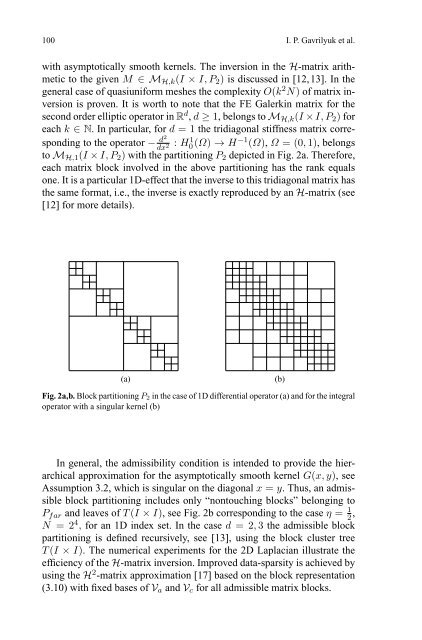H-Matrix approximation for the operator exponential with applications
H-Matrix approximation for the operator exponential with applications
H-Matrix approximation for the operator exponential with applications
You also want an ePaper? Increase the reach of your titles
YUMPU automatically turns print PDFs into web optimized ePapers that Google loves.
100 I. P. Gavrilyuk et al.<br />
<strong>with</strong>asymptotically smoothkernels. The inversion in <strong>the</strong> H-matrix arithmetic<br />
to <strong>the</strong> given M ∈M H,k (I × I,P 2 ) is discussed in [12,13]. In <strong>the</strong><br />
general case of quasiuni<strong>for</strong>m meshes <strong>the</strong> complexity O(k 2 N) of matrix inversion<br />
is proven. It is worth to note that <strong>the</strong> FE Galerkin matrix <strong>for</strong> <strong>the</strong><br />
second order elliptic <strong>operator</strong> in R d , d ≥ 1, belongs to M H,k (I × I,P 2 ) <strong>for</strong><br />
each k ∈ N. In particular, <strong>for</strong> d =1<strong>the</strong> tridiagonal stiffness matrix corresponding<br />
to <strong>the</strong> <strong>operator</strong> − d2 : H 1 dx 2 0 (Ω) → H−1 (Ω), Ω =(0, 1), belongs<br />
to M H,1 (I × I,P 2 ) <strong>with</strong><strong>the</strong> partitioning P 2 depicted in Fig. 2a. There<strong>for</strong>e,<br />
each matrix block involved in <strong>the</strong> above partitioning has <strong>the</strong> rank equals<br />
one. It is a particular 1D-effect that <strong>the</strong> inverse to this tridiagonal matrix has<br />
<strong>the</strong> same <strong>for</strong>mat, i.e., <strong>the</strong> inverse is exactly reproduced by an H-matrix (see<br />
[12] <strong>for</strong> more details).<br />
(a)<br />
(b)<br />
Fig. 2a,b. Block partitioning P 2 in <strong>the</strong> case of 1D differential <strong>operator</strong> (a) and <strong>for</strong> <strong>the</strong> integral<br />
<strong>operator</strong> <strong>with</strong>a singular kernel (b)<br />
In general, <strong>the</strong> admissibility condition is intended to provide <strong>the</strong> hierarchical<br />
<strong>approximation</strong> <strong>for</strong> <strong>the</strong> asymptotically smooth kernel G(x, y), see<br />
Assumption 3.2, which is singular on <strong>the</strong> diagonal x = y. Thus, an admissible<br />
block partitioning includes only “nontouching blocks” belonging to<br />
P far and leaves of T (I × I), see Fig. 2b corresponding to <strong>the</strong> case η = 1 2 ,<br />
N =2 4 , <strong>for</strong> an 1D index set. In <strong>the</strong> case d =2, 3 <strong>the</strong> admissible block<br />
partitioning is defined recursively, see [13], using <strong>the</strong> block cluster tree<br />
T (I × I). The numerical experiments <strong>for</strong> <strong>the</strong> 2D Laplacian illustrate <strong>the</strong><br />
efficiency of <strong>the</strong> H-matrix inversion. Improved data-sparsity is achieved by<br />
using <strong>the</strong> H 2 -matrix <strong>approximation</strong> [17] based on <strong>the</strong> block representation<br />
(3.10) <strong>with</strong>fixed bases of V a and V c <strong>for</strong> all admissible matrix blocks.
















